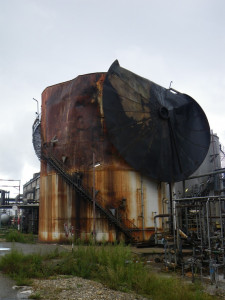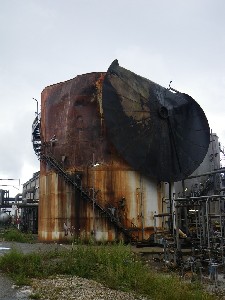Several lightning strikes were recorded in a refinery at 7:25 pm, one of which caused the expansion space to explode on a 2,000-m³ capacity buffer tank (for collection and settlement) filled with 770 m³ of process water. The hydrocarbon supernatants present in the tank due to malfunction of the fractionation process (stripper) exploded and ignited. The refinery operator activated the internal emergency plan at 7:45 pm and shut down several production units; the Prefecture contacted the Departmental Operations Centre at 8:09 pm. Also, at 8 pm, the mayor deployed the Municipal Rescue Plan and informed local residents (via phone calls, text messages and Website postings). The site’s fire-fighting crew extinguished the flames by 8:10 and the operator proceeded to cool the installation. An extinction foam blanket was spread over the tank bottom to avoid any further ignition risk. Public fire-fighters, also at the scene, did not need to intervene. The extinction water containing foam slightly polluted the Rhone River via the site’s stormwater network. The refinery set up floating booms. The Prefecture issued a press release. The Classified Facilities Inspectorate visited the site at 9:30 that evening. The tank’s stationary roof sustained heavy damage by tearing along the fragile weld connecting it to the tank wall. The roof was bound to part of the ring and hung outside the wall like the lid on a can. The next day, the operator secured the roof and installed a buffer tank bypass circuit. The tank had been equipped with a grounding device to prevent lightning current from spreading to the installation, but this device did not offer sufficient protection against nearby strikes (i.e. a lightning rod). The administration authorised a restart of idle units and requested an examination of the tank, along with an analysis of the lack of efficiency and adequate measures to protect the facilities from lightning.
The settlement phenomenon resulted in the formation of a thin layer of volatile surface hydrocarbons. The most likely hypothesis to explain this accident is the ignition of one or more vents. Combustion propagation inside the tank was followed by an explosion. The vents had only been fitted with a single “flame retardant” grating that did not provide the same level of safety as a “flame arrestor” system (custom equipment).
After obtaining feedback on the accident, the operator implemented an action plan by inventorying the capacities under identical process conditions and where “flame arrestors” might be missing.
While awaiting completion of an in-depth risk analysis, the potential prevention measures consisted of: tank inerting, installation of an internal floating screen, or placement of a “flame arrestor” on each vent.
Download the detailed report in .pdf format (101 Kb)





